

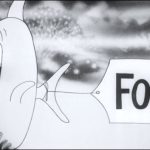
AUTHOR’S NOTE:
This article was published on my Patreon page in January 2023—with slight modifications in the text here. Since the series is going to the start of Bob Clampett’s directorial career, and for readers to keep abreast of the important details, here’s a link that presents the animator breakdown columns of Clampett’s first season of B&W Looney Tunes in production order. (Animator breakdown columns detailing Porky’s Poppa and Porky’s Five & Ten will follow within the next few weeks.)
LT-3: Porky’s Badtime Story
LT-4: Get Rich Quick Porky
LT-5: Rover’s Rival
LT-6: Porky’s Hero Agency
LT-7: Porky’s Poppa
LT-8: What Price Porky
LT-9: Porky’s Five & Ten
LT-10: Injun Trouble (also includes its 1945 remake, Wagon Heels)
LT-11: Porky’s Party
LT-12: Porky & Daffy
In Bob Clampett’s seventh black-and-white Looney Tune, Chuck Jones shares the animation credit with John Carey, always credited as “Jack” in the production papers (his full name was Jack Nelson Carey). The title refers to Porky setting sail to the Boola Boola Isle with enough inventory to open a “five-and-ten” store. (The fictional tropical island of Porky’s destination suggests Yale University’s fight song and college cheer, “Boola Boola,” which originated in 1900 and doubled as a contemporary slang term for chauvinism among college football teams.) During the first half of 20th-century America, “five-and-ten” stores, a precursor to today’s variety shops, sold inexpensive merchandise for a nickel or dime: Woolworth’s and its competitor, S. S. Kresge, were prime examples of fixed-price corporations.
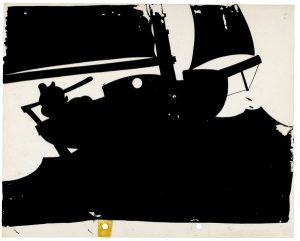 The opening title card introduces Porky as he reclines on his boat, the Petunia, as she bobs up and down on the ocean waves in a solid black silhouette. Carl Stalling takes advantage of the sailing motif with “Let That Be a Lesson To You,” a recent Johnny Mercer-Richard Whiting hit tune from Warner Bros.’ musical Hollywood Hotel; the song illustrates the “lesson” of Christopher Columbus’ historic voyage in 1492. Porky sets off to Boola Boola Isle with his large mountain of wares, as he expresses various goodbyes, with the song “Farewell My Love” (Lou Holzer-Harry Kogen-Henry Busse), a fitting inclusion by Stalling. Thirteen days pass, and sailor Porky reports in his logbook that he hopes to spot land, quickly adding, “I hope, I hope, I hope,” a reference to a signature catchphrase spoken frequently by traveling salesman Elmer Blurt from radio’s Al Pearce and His Gang.
The opening title card introduces Porky as he reclines on his boat, the Petunia, as she bobs up and down on the ocean waves in a solid black silhouette. Carl Stalling takes advantage of the sailing motif with “Let That Be a Lesson To You,” a recent Johnny Mercer-Richard Whiting hit tune from Warner Bros.’ musical Hollywood Hotel; the song illustrates the “lesson” of Christopher Columbus’ historic voyage in 1492. Porky sets off to Boola Boola Isle with his large mountain of wares, as he expresses various goodbyes, with the song “Farewell My Love” (Lou Holzer-Harry Kogen-Henry Busse), a fitting inclusion by Stalling. Thirteen days pass, and sailor Porky reports in his logbook that he hopes to spot land, quickly adding, “I hope, I hope, I hope,” a reference to a signature catchphrase spoken frequently by traveling salesman Elmer Blurt from radio’s Al Pearce and His Gang.
Another musical selection from Hollywood Hotel, “I’m Like a Fish Out of Water,” plays when a gang of larcenous fish discovers Porky’s vessel at sea. A swordfish’s serrated proboscis cuts a hatchway door underneath, which sinks the cargo to the bottom of the ocean floor. The swordfish shoves Porky back inside, unscrews his “blade,” and arms a smaller fish to stand guard beneath the ship’s hull bottom. The song title might have inspired Clampett to dedicate many of the sight gags of fish cavorting with consumer goods. Porky gets little screen time compared to Clampett’s earlier Looney Tunes; much of the footage is devoted to its underwater sequences. (“Sing, You Son of a Gun,” from Hollywood Hotel, plays in the music score during scenes of Porky in the boat cabin.)
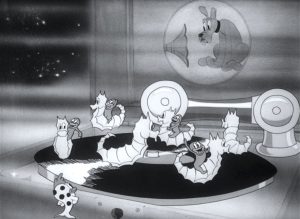 When a herd of seahorses operate a portable gramophone like a fairground carousel (with a Pluto-esque hound resembling Nipper, the RCA Victor dog), Dave Franklin and Cliff Friend’s “The Merry-Go-Round Broke Down” accompanies the action. The music continues when one fish swallows a teapot and assumes its shape; its whistling spout toots the song’s “ump-pah-pah” measure. Another Dave Franklin-Cliff Friend composition, “How Many Rhymes Can You Get (I Love to Rhyme With You),” segues into a sequence animated by Chuck Jones: a curious fish ingests a pendulum clock; its lower body soon swings back and forth like a metronome as they exit the frame in utter disbelief. Clampett then pays tribute to Bill Holman’s comic strip Smokey Stover: a fish floats across the screen with a tag reading “FOO” tied to its tail fin.
When a herd of seahorses operate a portable gramophone like a fairground carousel (with a Pluto-esque hound resembling Nipper, the RCA Victor dog), Dave Franklin and Cliff Friend’s “The Merry-Go-Round Broke Down” accompanies the action. The music continues when one fish swallows a teapot and assumes its shape; its whistling spout toots the song’s “ump-pah-pah” measure. Another Dave Franklin-Cliff Friend composition, “How Many Rhymes Can You Get (I Love to Rhyme With You),” segues into a sequence animated by Chuck Jones: a curious fish ingests a pendulum clock; its lower body soon swings back and forth like a metronome as they exit the frame in utter disbelief. Clampett then pays tribute to Bill Holman’s comic strip Smokey Stover: a fish floats across the screen with a tag reading “FOO” tied to its tail fin.
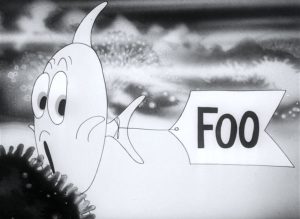 Chuck Jones’ animation dominates the cartoon in an extensive 73-foot sequence. One hapless fish swallows a radio to destructive gastronomical effect: the fish calmly struts along until a news broadcast transmits from inside his stomach, which details a peaceful village invaded by “two giant bombers.” At first, the fish shrugs it off and continues on their way; the sounds of bombing and rapid gunfire thrash the poor fish into large explosive bursts and violent spasms. (Clampett most likely derived the “vivid picturization of news of the week” from the infamous Guernica bombing in April 1937, initiated by Nazi Germany and Italian air forces during the Spanish Civil War.) The bombardment ends, the fish wipes his brow in relief, but a new program, “Gangster Busters,” (a spoof on radio’s Gang Busters) begins, followed by police sirens and a hail of machine gun fire.
Chuck Jones’ animation dominates the cartoon in an extensive 73-foot sequence. One hapless fish swallows a radio to destructive gastronomical effect: the fish calmly struts along until a news broadcast transmits from inside his stomach, which details a peaceful village invaded by “two giant bombers.” At first, the fish shrugs it off and continues on their way; the sounds of bombing and rapid gunfire thrash the poor fish into large explosive bursts and violent spasms. (Clampett most likely derived the “vivid picturization of news of the week” from the infamous Guernica bombing in April 1937, initiated by Nazi Germany and Italian air forces during the Spanish Civil War.) The bombardment ends, the fish wipes his brow in relief, but a new program, “Gangster Busters,” (a spoof on radio’s Gang Busters) begins, followed by police sirens and a hail of machine gun fire.
Halfway into the cartoon, Clampett pokes fun at Hollywood entertainment when the remainder of Porky’s merchandise lands on the seabed and creates an undersea replica of Hollywood Hotel. Electric eels act as neon signs; a pair of fish use flashlights to simulate searchlights. Bill Days, the lead tenor of The Sportsmen Quartet (a vocal group frequently heard in Warner cartoons), croons “Happiness Ahead” from the titular 1934 Dick Powell musical vehicle directed by Mervin LeRoy and produced by Warner Bros.-First National. Chuck Jones shares joint credit with Lucifer “Lu” Guarnier for the sequence. Guarnier started at Leon Schlesinger’s in January 1937 as an in-betweener and soon became Chuck Jones’s assistant. (Lu received sole credit for one scene in the production draft for Porky’s Badtime Story, Clampett’s first cartoon as director.)
 “Hooray for Hollywood,” the most noteworthy tune from Hollywood Hotel, is sung (by the Rhythmettes) when different items in Porky’s “five-and-ten” alter the fish to resemble famous movie stars: a pair of derby hats fall onto two fish, who then reveal themselves as Laurel and Hardy; a fish becomes Greta Garbo when she slips into oversize shoes (her notoriously large feet a constant subject of ridicule in Hollywood culture) and delivers her famous quip from Grand Hotel, “I vant to be alone”; a fish devours an oil lamp chimney and gains the buxom figure of Mae West, including her sauntering stride and sultry asides. The late Cara Williams (1925-2021), known then as Bernice Kamiat, provided the Garbo and Mae West impersonations.
“Hooray for Hollywood,” the most noteworthy tune from Hollywood Hotel, is sung (by the Rhythmettes) when different items in Porky’s “five-and-ten” alter the fish to resemble famous movie stars: a pair of derby hats fall onto two fish, who then reveal themselves as Laurel and Hardy; a fish becomes Greta Garbo when she slips into oversize shoes (her notoriously large feet a constant subject of ridicule in Hollywood culture) and delivers her famous quip from Grand Hotel, “I vant to be alone”; a fish devours an oil lamp chimney and gains the buxom figure of Mae West, including her sauntering stride and sultry asides. The late Cara Williams (1925-2021), known then as Bernice Kamiat, provided the Garbo and Mae West impersonations.
The fight arena resembles the real Hollywood Legion Stadium, a beloved venue from the 1920s to the 1950s. Promotional posters reveal the two boxers, Jack Sharkey and Gene Tuna, spoofing professional heavyweight fighters Jack Sharkey (1902-1994) and Gene Tunney (1897-1978), respectively. (Sharp-eyed viewers may also notice a reference to storyman Lew Landsman, whose first name is spelled “Lu” on its placard.) An alternate lyric in “Hooray for Hollywood,” heard during the boxing match, changes its original line from “Go out and try your luck, you might be Donald Duck,” to “Daffy Duck,” obviously to avoid referencing Disney’s character. (This substitution is also in Friz Freleng’s Merrie Melody, A Star is Hatched, released alongside Porky’s Five and Ten.)
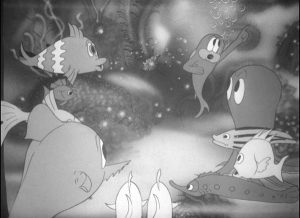 Inside the ballroom of the aquatic Hollywood Hotel, a stage curtain reveals the shapely legs of a chorus line. The curtain lifts further up: it’s a 10-legged octopus! Bobe Cannon animates a scene with the fish who swallowed the pendulum clock, now accustomed to its effects as it performs a hootchy-kootchy dance to “Bei Mir Bist Du Schön,” a smash hit popularized by the Andrews Sisters during the cartoon’s production. Cannon also animates the scene of the fish guard instigating a whale to douse Porky with water through its blowhole.
Inside the ballroom of the aquatic Hollywood Hotel, a stage curtain reveals the shapely legs of a chorus line. The curtain lifts further up: it’s a 10-legged octopus! Bobe Cannon animates a scene with the fish who swallowed the pendulum clock, now accustomed to its effects as it performs a hootchy-kootchy dance to “Bei Mir Bist Du Schön,” a smash hit popularized by the Andrews Sisters during the cartoon’s production. Cannon also animates the scene of the fish guard instigating a whale to douse Porky with water through its blowhole.
Suddenly, a large waterspout travels near the Boola Boola Isle. Back on the ocean floor, in a scene animated by John Carey, a radio newscaster reports the emergency; the fish ignore the announcement and continue to dance; the voice quickly urges the ignorant sea creatures to “scram!” When the fish dash for cover, Clampett wields Mort Dixon and Harry Warren’s “Nagasaki” to underline the climactic danger, as in the earlier Rover’s Rival. The waterspout whirls Porky and his vessel around and vacuums up all his miscellaneous items, which land in place on the boat. Before our hero steers ahead to Boola Boola Isle, he returns to spray seltzer at the fish guard in retaliation—the fish lets out a whimpering cry, a la Stan Laurel, as the cartoon irises out.
Porky’s Five and Ten premiered in New York’s Strand Theater on March 26, 1938, with a consecutive showing on April 2—its general nationwide release took place on April 16.
Porky’s Five & Ten (animator breakdown):
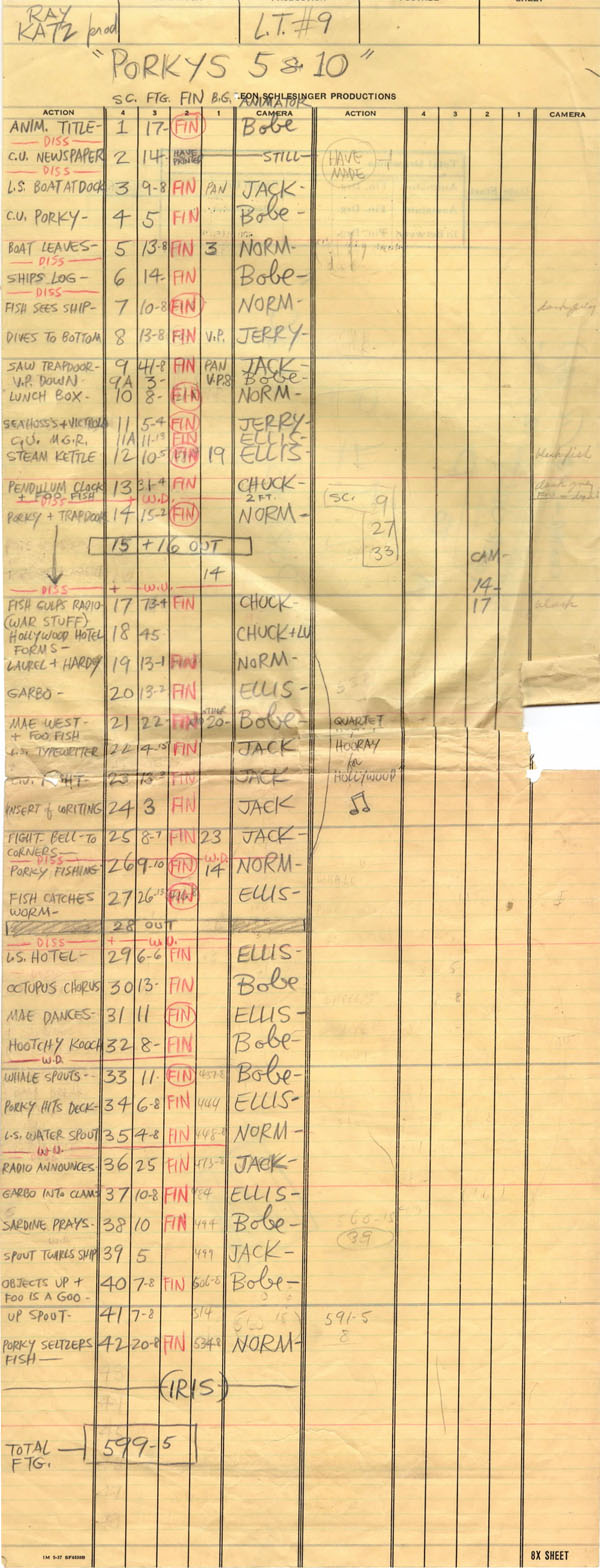
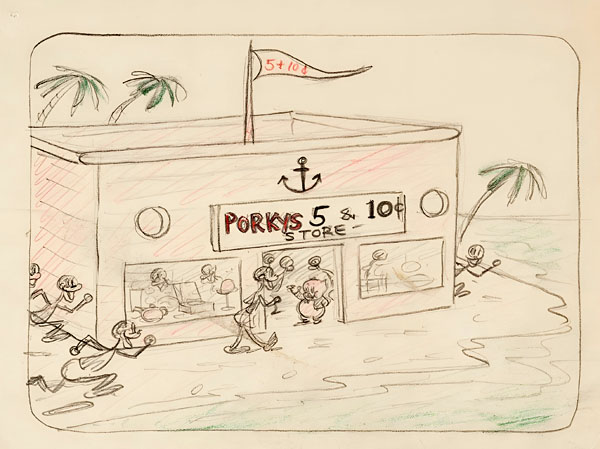
Porky’s Five and Ten story sketch – photo caption: This story sketch, recently unearthed from the Clampett estate, shows Porky on an island filled with natives turned shoppers, a story element that Clampett wisely deleted from the picture.